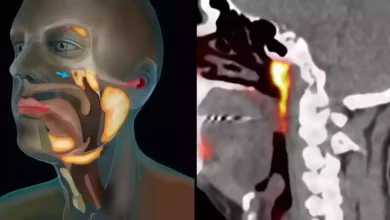A surprising factor can predict dementia up to 12 years in advance, study finds

The eyes can reveal a lot about our brain health. In fact, eye problems can be one of the first signs of cognitive decline. Our latest study shows that loss of visual sensitivity can predict dementia 12 years before diagnosis.
Our research was based on 8,623 healthy people in Norfolk, England, who were followed for many years. By the end of the study, 537 participants had developed dementia, so we were able to see what factors might have preceded this diagnosis.
At the start of the study, we asked participants to take a visual sensitivity test. For the test, they had to press a button as soon as they saw a triangle forming in a field of moving dots. People who would develop dementia were much slower to see this triangle on the screen than people who would not have dementia.
So why might this be the case?
Visual problems may be an early indicator of cognitive decline, as toxic amyloid plaques associated with Alzheimer’s disease may first affect areas of the brain associated with vision, with parts of the brain associated with memory becoming damaged over time. as the disease progresses. Thus, vision tests can detect deficits before memory tests.
Several other aspects of visual processing are affected in Alzheimer’s disease, such as the ability to see the outlines of objects (contrast sensitivity) and to discern certain colors (the ability to see the blue-green spectrum is affected early in Alzheimer’s disease). dementia). , and these can affect people’s lives without them immediately realizing it.
Another early sign of Alzheimer’s disease is a deficit in the “inhibitory control” of eye movements, where distracting stimuli seem to hold attention more easily. People with Alzheimer’s disease seem to have difficulty ignoring distracting stimuli, which can manifest as problems controlling eye movements.
If dementia makes it more difficult to avoid distracting stimuli, then these problems could increase the risk of driving accidents – a topic we are currently researching at Loughborough University.
Recognize faces
We have data suggesting that people with dementia tend to process the faces of new people inefficiently. In other words, they don’t follow the usual pattern of scanning the face of the person they’re talking to.
In healthy people, this would be from the eyes to the nose to the mouth. We do this to “print” the face and remember it for later. People can sometimes feel that the other person is not doing this.
In fact, some doctors working with people with dementia will recognize that a person has dementia when they meet them. People with dementia may sometimes appear lost because they do not deliberately move their eyes to scan the surroundings, including the faces of people they have just met.
It would follow that you would then be less able to recognize people, because you have not imprinted their features. So this early problem of not recognizing people you’ve just met might be related to inefficient eye movement to new faces, rather than a pure memory disorder.
Can eye movement improve memory?
However, because visual sensitivity is linked to memory performance (even using non-visual tests), we also test whether getting people to make more eye movements helps improve memory. Previous research on the subject is mixed, but some studies have shown that eye movement can improve memory. This may explain why we found that people who watch more TV and read more have better memory and less risk of dementia than those who don’t.
When we watch TV or read, our eyes scan the page and the TV screen. However, people who read often also tend to have been in school longer. Having a good education provides brain reserve capacity, so when brain connections are damaged, the negative outcome is less.
In other studies, rapid left-to-right and right-to-left eye movements (two eye movements per second) were found to improve autobiographical memory (the story of your life). However, some studies suggest that this beneficial effect of eye movement only benefits right-handed people. We don’t know why.
Despite these exciting findings, treatment of memory problems using deliberate eye movements in older adults has not yet been much developed. Additionally, using eye movement deficits as a diagnosis is not common practice, despite the possibilities afforded by eye movement technology.
One bottleneck could be access to eye-tracking technologies, which are expensive and require training to use and analyze. Until cheaper, easy-to-use eye tracking devices are available, using eye movements as a diagnostic tool for early-stage Alzheimer’s disease is not possible outside of the laboratory.![]()
This article is republished from The Conversation under a Creative Commons license. Read the original article.
News Source : www.psypost.org
Gn Health





